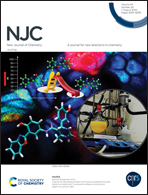Stimuli-responsive supramolecular polymer network based on bi-pillar[5]arene for efficient adsorption of multiple organic dye contaminants†
Abstract
A novel supramolecular polymer network gel (NT), based on bi-pillar[5]arene, which can adsorb and separate organic dyes, has been efficiently constructed. First, a novel supramolecular gelator, NBP5 (host), and a tripodal guest, TG (guest), were successfully designed and synthesized. The host NBP5 and guest TG constructed a stable supramolecular polymer network gel, NT, via π–π interactions, hydrogen bonding interactions and host–guest interactions in DMSO/H2O solution. Interestingly, NT showed multi-responsiveness toward outer stimuli, such as temperature, mechanical, concentration, pH and competitive guests. More importantly, NT can carry out the adsorption and separation of organic dyes such as methylene blue, crystal violet, methyl orange, orange I, sudan I and sudan II by the complex intermolecular interactions. The adsorption rates of this gel for dyes are in the range of 83.15–97.56%, indicating good adsorption properties. Moreover, the xerogel of NT can desorb in ethanol solution, showing good recyclability. The multi-responsiveness and adsorption separation properties are based on the multi-interaction sites that were rationally introduced into the NT. Therefore, this is a convenient method for the preparation of supramolecular polymer network-based multiple functional smart materials.
![Graphical abstract: Stimuli-responsive supramolecular polymer network based on bi-pillar[5]arene for efficient adsorption of multiple organic dye contaminants](/en/Image/Get?imageInfo.ImageType=GA&imageInfo.ImageIdentifier.ManuscriptID=D0NJ02524K&imageInfo.ImageIdentifier.Year=2020)


 Please wait while we load your content...
Please wait while we load your content...